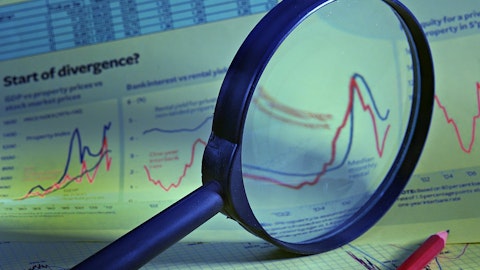Chris Koch: Yes. Saree, I would also say, Chris here, that COS, we buy an organization, especially the magnitude of Henry, and we roll COS out. It typically tends to be very well received. And I think Frank Ready and the team at Henry have embraced COS. And so we think we’ve got some upside there because they’re in the early innings of that lean sigma rollout, so that should help. And then obviously, we are applying €“ with a longer-term view that Carlisle has, we’re applying a little bit more focus on automation and capital investment in our factories, so we should get some efficiency there. And then we also had some portfolio action in there, and we talked about that rubber business, which actually was taking away from margin in 2022. And with that out of the mix, that will boost that margin up. So when you look at those things altogether, it gives us quite a few vectors to work on and also see some nice returns.
Saree Boroditsky: Great. And then you had a competitor announce who was buying DuralastI believe today. Can you just talk about any impact to the competitive environment as they continue to make acquisitions in the space?
Chris Koch: Yes. It’s for us, it’s an interesting situation. I believe they bought Malarkey earlier, and that’s a residential shingle organization doesn’t affect us too much. I mean I can’t really think that impacts our commercial roofing business or CWT business. And now this acquisition of Duralast, great company. We know Duralast very well. They have a great product, but they’re really not a competitor to us in our commercial roofing space. They really deal, I would say, in a kind of a smaller square foot size and maybe in some different segments that we compete in. So that’s a great business, great family business. And so they’ll €“ I’m sure they’ll do well with that. But the impact on it should be minimal. I think going forward, we would obviously €“ they’re stated they want to grow in North America.
And obviously, Carlisle wants to grow in North America, and we’re acquisitive, and they want to be acquisitive. So I would imagine we will run into that team again as assets come up on the horizon.
Saree Boroditsky: Great. Thanks for the color and congrats on the quarter.
Chris Koch: Thank you very much.
Operator: Thank you, Ms. Boroditsky. The next question is from David MacGregor with Longbow Research. Please proceed.
David MacGregor: Yes, good afternoon everybody. I guess, I just want to go back to CCM. And fourth quarter, I think a normal seasonality there as being kind of down 15% sequentially versus the third quarter. You were down kind of 2 times that. It looks like there was obviously more than seasonality here. Kevin referenced the snowstorms in the U.S. Maybe for starters, can you just quantify the impact to some of these other things beyond seasonality might have had there and help us break this down a little bit?
Kevin Zdimal: Right. The biggest piece, I mean, the weather was there, but it’s also just how we’ve talked about it in the last earnings call and this one, there’s normalization of the buying patterns that what we had throughout 2022, folks were on allocation and being on allocation. People are buying what they could get their hands on. And they basically bought ahead in the first part of 2022. And that was really the biggest reason why in the fourth quarter as customers brought inventory levels down that impacted that piece. So we would not say 2022 was a normal year of seasonality. We think even bright and to go back pre-COVID and look at how those years broke out as far as quarter-by-quarter, like you’re looking to do from Q3 to Q4 because as we get back to normal, a lot of that will be in play, and you can look at it that way.
I pointed out what Q1 would be not normal this year. But then once we get to Q2 and the balance of the year, we think that will be more normal. And as a result of what happened in 2022, the fourth quarter is going to be an easy comp for 2023.
David MacGregor: Excluding that €“ sorry, go ahead.
Chris Koch: No, go head, David.
David MacGregor: No, I was just going to ask, do you think excluding that sort of the reconciliation of the pre-buy and the weather that you were closer to that kind of 15% down sequential pattern that would be sort of the typical seasonality, I’m just trying to quantify some of this.
Chris Koch: Yes, David, I’m going to jump in here just because I think what Kevin said is important, and I just want to make sure we recognize. We look at what CCM organic growth was probably prior to 2020, which was in COVID hit, right, Feb 2020, I’d say, or March of 2020. We’ve been tracking to that mid-to-high single digits, and it had been going there. And I think we’ve always said new construction in the two, three, four and reroofing in the four, five, six or something like that seven. And it held pretty much there, and I’m talking organic. In 2020, we were down 7.5% and then we were up almost 22% and then 22% up 37% in organic growth. So I think when we look at those numbers, we kind of know if the long-term trend in these underlying fundamentals, which are super strong and have been very consistent with CCM for a long time, are going to kind of repeat themselves.
There had to be some, I guess, reversion to the mean. And I think that’s what was working it out in Q4. And I think that’s why Kevin made that statement of what’s normal. And I don’t really know that we’re going to be able to pick apart with what I just told you and make any real sense of it because when you think how many contractors and distributors that we interface with and you think of what the variability might be in each region, and in each location with what they could carry on inventory and how quick they’re going to get out of that. It just gets super complicated. So I know that doesn’t help you, but I think what Jim and Kevin are trying to say is just as we move into 2023, we’re getting back to that pre-COVID cadence, it’s a strong cadence.
It’s got great growth on the underlying demand with leverage. And really, just €“ I just think as we come out of that, we just have to take it what these three years has been, which is just a very much an anomaly. And I think when you at the team did to manage through it, great job. But trying to parse that apart, I don’t think we can do it.
David MacGregor: Yes. Okay. I appreciate that. Thanks, Chris. Just as a follow-up. I guess, within the guidance, you’ve got Sykes in ramping here in the second quarter. Is that going to be a temporary drag to the P&L? And if so, how should we phase that over the quarters in our models?
Chris Koch: Jim?




